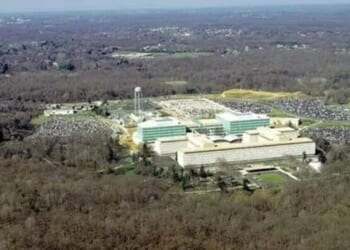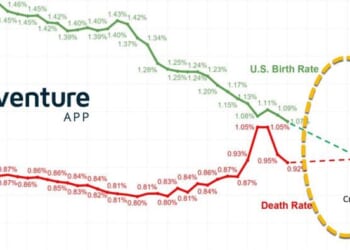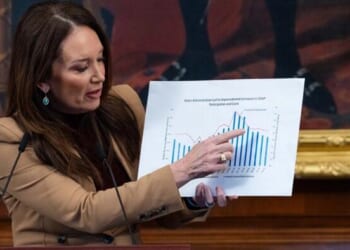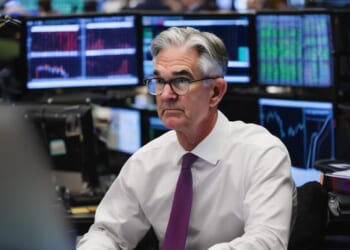Authored by Edward Ring via American Greatness,
To paraphrase and utterly subvert one of Karl Marx’s best-known quotes, a “spectre” is haunting Silicon Valley—the spectre of authentic abundance. All the powers of woke California have entered into an unholy alliance to exorcise this spectre: public sector unions, the environmentalist lobby, the crony capitalists, Antifa radicals, and Reddit trolls.
They’re going to lose. For all the power the state’s ruling unholy alliance still wields with its “No Kings” populism, its partisan Prop. 50 redistricting, and its absolute grip on state and local governance, it is now in conflict with a far greater historical and cultural momentum. Innate to California and irrepressible, the forces of innovation and creativity that have defined the state for nearly two hundred years are asserting themselves in new domains. Authentic abundance is on the way, and nothing can stop it.
It’s about time. For decades, with an intensity that exploded during the first Trump presidency and crested during the Biden administration, liberals and progressives and woke ideologues have exercised sway over the valley. But through it all, their core message was always anathema to the entrepreneurial spirit that defined the culture. Because the core message of woke is NO. This core message is psychological—you will be sensitive, you will respect the paradigm of oppression—but it is also physical: energy rationing, water rationing, i.e., embrace scarcity.
For a while, the unholy alliance was indulged. As long as Silicon Valley remained a destination where a brilliant engineer could show up from anywhere on earth with an idea that could change the world, the slow infiltration of woke scolds into their growing corporations was tolerable. The dazzling and sudden wealth, the amazing breakthroughs, the sheer excitement of being in the technology epicenter of the world—these perks overshadowed the growing encroachment. But they went too far.
The anti-woke rebellion, now well underway, was bound to happen. The foundation of Silicon Valley culture is the power of lone individuals with big ideas and big brains, individuals with tunnel vision and uncontainable drive. That’s what it takes to change the world, and for every successful company founder, the valley was littered with the remains of fallen competitors. It was, and is, one of the most ruthlessly competitive expressions of pure capitalism the world has ever seen. And it delivered, decade after decade.
The cliches that help define Silicon Valley are accurate ways to describe how the people working there think and what they have accomplished. Better, faster, cheaper. Moore’s Law (the principle that the speed and capability of computers can be expected to double every two years). Creative destruction. The “unicorn” chase (building a company to a $1 billion valuation). Hustle culture. Tech bros. Synergy.
On the surface, these phrases seem shallow. Except they are a way of life. And the results speak for themselves. The transistor. The chip. The mainframe, the mini, the workstation, the PC, the laptop, the internet, the iPhone, the smartphone, and AI. In less than one lifetime, we traversed that landscape. The world will never be the same.
But suddenly, a glitch has appeared in the matrix. If every high-tech product has become better, faster, and cheaper, why is everything else so expensive? Why can’t we produce cheap energy, deliver abundant and affordable water, and produce homes that people with average incomes can afford and want to live in? Why is it that a flat-screen television is dirt cheap, while owning a modest home is now completely out of reach for almost every young married couple in America?
It’s about time the titans of Silicon Valley turned their attention to these challenges. Steps along the way have been eye-openers. A few years ago, a group of Silicon Valley investors came together to acquire land and build new homes—an entirely new community—on huge tracts of underutilized land north of San Francisco. What could possibly go wrong? The proposal would have increased the housing supply in a region enduring a desperate shortage of new homes. It was situated near a major freeway corridor, within commuting range of San Francisco. They were going to do everything right, with sustainably sourced water and electricity, a generous percentage of low-income housing, energy-efficient smart buildings, and provisions for mass transit. Wouldn’t everyone want this to happen? It would be a slam dunk!
And then reality intervened. Every public entity remotely within the footprint of the planned community had demands, mostly impossible to meet, delivered by politicians whose campaign benefactors were the perennially powerful public sector unions. Every landowner who didn’t want to see their rural lifestyle disrupted gained disproportionate support from environmentalist litigators, brilliantly exploiting every one of California’s nearly infinite array of environmental laws and regulations.
So much for abundant housing, because the only thing the unholy alliance produces in abundance is new home-killing regulations and litigation. It afflicts aspiring builders everywhere in California. Pay. Pay more. Wait. Wait some more. Lose. Try again, and lose again. Give up. Go to Texas, where they still want homebuilders.
What about abundant energy? This, too, is unavailable, despite the billions that Silicon Valley investors are prepared to spend on data centers to process AI queries to, you know, cure disease, guarantee national security, save the world, and make sure any random inquirer can know which episode of Miami Vice included the song “Red Rain.” But instead of converting these deliverables into reality, investors must contend with a state determined to achieve “net zero” by 2045, a state that wants to electrify the entire economy and yet is mired in regulations that won’t even fast-track approval of energy solutions that are “carbon-free.”
As for water, options are limited, to put it mildly. Desalination? Gotta go through the Coastal Commission, so… forget it. Surface reservoirs? The long-promised Sites Reservoir, allegedly a major reservoir project that is close to actually getting built, remains mired in procedural delays and litigation even as its lead proponents continue to assiduously attend conferences to smile, shake hands, and prosper off the process instead of the result. What about wastewater recycling? Sure, but you’ll still spend 10-20 years just getting approval to begin construction.
It almost should go without saying that the woke culture that scuttled James Damore’s career at Google was not going to last. Nor was the whole infrastructure of parasitic human resources departments that large tech corporations were forced to create in order to elevate their percentage of diversity hires to acceptable regulatory norms. The founders of these mega companies did everything they were told to do by the woke. Until they didn’t.
The last straw wasn’t the unholy alliance demanding adherence to the oppressor vs. oppressed paradigm, enforced by parasitic HR departments. That annoyance just put the last straw into context and ensured that once it came, a more comprehensive realignment would ensue. But the last straw, which violated every core principle that ever animated a genuine entrepreneur, was when they realized how California’s ruling class had basically outlawed production of more energy, water, housing, and every other physical essential that requires so much as a scratch in the earth.
Not lost on Silicon Valley’s awakened entrepreneurs was that, at the same time as the unholy alliance is making abundance more impossible than ever to achieve, they’ve adopted “abundance” as a new weapon in their rhetorical arsenal. It isn’t working. The insincerity is brazen, and the backlash is undiminished.
Now, the notion not of “abundance” as a campaign buzzword, but as authentic, actual abundance, stalks the conference rooms and Zoom calls and animates discussions in the valley with a fervor that was previously restricted to code and chip design. We will have affordable homes. We will have abundant energy. We are not going to accept inadequate supplies of water. We have found a new frontier to conquer, and we will not lose.
A wonderful driver of Silicon Valley’s rising abundance culture and the evolving political philosophy that constitutes its true ideological foundation can be found in the articulate ravings of a relatively new publication, Pirate Wires. The insouciance of this publication had print magazine predecessors in the previous generation. Mondo 2000. Upside. Wired. The Red Herring. But those first translations of Silicon Valley energy into Silicon Valley culture were ahead of their time and mostly apolitical. It took politically contrived scarcity hitting home, combined with woke overreach, for voices to emerge that not only had an edge but also moved way beyond chips and code.
In a rebuttal to the ersatz, limited vision of abundance promoted by liberals Klein and Johnson in their recent bestseller “Abundance,” Pirate Wires editor Mike Solana wrote an essay, “The Abundance Delusion.” Published by The Atlantic last summer, it is a masterpiece. Solana has given us a Jetsonesque vision of the future. It is a beautiful, utterly uninhibited, uncompromising paeon to a Tomorrowland that Silicon Valley has both the wealth and the brainpower to deliver, and the sooner, the better. Here is my favorite paragraph from this work of art:
“I want a bullet train that rips across the country from San Francisco to New York in half a day. I want to take that ride in a first-class cabin, with a little bar car somewhere onboard where I can talk shit with strangers over martinis as we travel through the Rockies. Fuck it, let’s throw in a robot bartender. I want genetically modified hydroponic gardens. I want special economic zones for manufacturing, for rare-earth-metals mining and processing, for rocketry and electric vehicles, and every other high-tech project you can think of, a reality in which Americans are liberated from local regulations that kneecap our industrial output—a reality in which our capacity is limited only by our imagination. I want gene drives, which means the eradication of invasive Burmese pythons in the Florida wetlands, the screwworm, and pretty much all mosquitoes. I want weather modification. I want geoengineering. I want to terraform Mars into a habitable world. I want a giant “Justice” statue, to complement the East Coast’s “Liberty,” on Alcatraz Island. I want this statue to depict an objectively hot person. Finally, the Moon should be a state, and no I won’t be taking any further questions.”
Having been a big fan of Pirate Wires for over a year, I can say with reasonable confidence that while these guys are clearly having a roaring good time, they are not playing. Something epic is happening in Silicon Valley today. It is a seismic shift, and it is long overdue. We are on the cusp of an urban renaissance that will be enabled by technology; it is going to be insanely excellent, and this new, even more expansive iteration of Silicon Valley is going to catalyze its progress.
This vision of the future is as optimistic and realistic as it is contagious and inspiring. We will expand our cities underground to accommodate infrastructure and transportation, and communication conduits, using new, far more cost-effective tunneling equipment such as that pioneered by the Boring Company. We will build our cities further upwards to accommodate drone ports and indoor farms, and we will employ creative parasitic architecture to enhance and enlarge legacy structures. If we want to, we will increase the per capita usable surface area in urban centers, both indoors and outdoors, even as we maintain or even increase the population density per square mile.
As dreams become reality, the next generation of smart buildings will not only be nearly self-sufficient in water and energy consumption through recycling, but they will also be much easier to maintain. Buildings will have photovoltaic skin, including the windows, battery storage using safe and inexpensive technologies, and spacious areas, including ample areas for plants and natural light, and often utilize mass timber as a structural material.
The technology-driven renaissance we are only now fully entering will change the rules, making projects profitable that previously could not possibly attract investment. Recycling practices that are economically impossible today, along with construction projects that so far have been economically infeasible, will become cost-effective propositions when robots begin to coordinate and manage increasingly automated processes to aid in recycling, construction, hazardous waste management, and critical maintenance. Highly skilled, labor-intensive jobs will be done by machines, dramatically lowering costs.
We will have flying cars after all. We will have robots and androids and colonies on Mars. And it will be unleashed by competitive capitalism as practiced by a new generation of Silicon Valley entrepreneurs who not only rejected but also completely eradicated the woke mind virus and vanquished the special interests who profited from scarcity.
Loading recommendations…
















